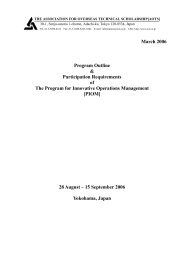Analysis of the Operation and Financial Condition of the Enterprise
Analysis of the Operation and Financial Condition of the Enterprise
Analysis of the Operation and Financial Condition of the Enterprise
You also want an ePaper? Increase the reach of your titles
YUMPU automatically turns print PDFs into web optimized ePapers that Google loves.
<strong>Analysis</strong> <strong>of</strong> <strong>the</strong> <strong>Operation</strong> <strong>and</strong> <strong>Financial</strong> <strong>Condition</strong> <strong>of</strong> <strong>the</strong> <strong>Enterprise</strong>Usually it is believed that <strong>the</strong> higher <strong>the</strong> liquidity ratio, <strong>the</strong> higher <strong>the</strong> liquidity <strong>of</strong>an enterprise. However, not always, as <strong>the</strong> calculation method <strong>of</strong> this ratio has a fewdrawbacks: Let us assume upon calculation <strong>of</strong> <strong>the</strong> ratio that all current assets are liquid.This assumption may be unrealistic, especially in respect <strong>of</strong> inventories; The ratios may be increased as a result <strong>of</strong> unfavourable processes; Liquidity ratios may on some occasions be transferred into <strong>the</strong> opposite –<strong>the</strong> liquidation ratio. Only in <strong>the</strong> case <strong>of</strong> liquidation an enterprise sells a largeamount <strong>of</strong> stock in order to repay its short-term liabilities; This ratio reflects a static situation – <strong>the</strong> status as <strong>of</strong> a certain date. Turnover<strong>of</strong> assets is not taken into consideration in <strong>the</strong> calculation.Due to <strong>the</strong>se reasons when making analysis <strong>of</strong> <strong>the</strong> enterprise liquidity a variety <strong>of</strong>factors need to be considered by drawing conclusions from <strong>the</strong> liquidity ratios calculated.For example, <strong>the</strong> specifics <strong>of</strong> <strong>the</strong> enterprise operations must be taken into account. Inproduction or construction enterprises <strong>the</strong>re will be a considerable excess <strong>of</strong> <strong>the</strong> percentage<strong>of</strong> stock over cash assets than in enterprises operating in trade. The application <strong>of</strong> <strong>the</strong>debtors’ collection policy also needs to be taken into account. If <strong>the</strong>re is a short debtcollection period, <strong>the</strong> balance sheet will reflect a small amount <strong>of</strong> debt, while a long period<strong>of</strong> collection may be reflected in <strong>the</strong> balance sheet as a considerable amount <strong>of</strong> debtors’debts. It has to be noted also what is <strong>the</strong> structure <strong>of</strong> stock <strong>and</strong> accounts receivable in anenterprise. Nei<strong>the</strong>r <strong>the</strong> non-liquid stock, nor bad debtors for which an adjustment has notbeen made do reflect <strong>the</strong> true financial position <strong>of</strong> an enterprise. Also <strong>the</strong> relationshipbetween short-term <strong>and</strong> long-term assets from <strong>the</strong> total enterprise property, <strong>the</strong> relationshipbetween unrealisable <strong>and</strong> readily realisable assets from total assets, <strong>the</strong> relationshipbetween current assets <strong>and</strong> short-term liabilities (<strong>the</strong> dynamics <strong>of</strong> <strong>the</strong> cover ratios), <strong>the</strong>dynamics <strong>and</strong> <strong>the</strong> reasons for changes in own working capital, <strong>the</strong> rate <strong>of</strong> own workingcapital in <strong>the</strong> structure <strong>of</strong> current assets has to be taken into consideration too.According to <strong>the</strong> degree <strong>of</strong> liquidity current assets may be sub-classified intothree groups, <strong>the</strong>y each differ by composition <strong>of</strong> current assets accepted as a cover for <strong>the</strong>repayment <strong>of</strong> short-term liabilities: highly liquid assets which are readily realisable (cash assets).These are liquid assets that are at <strong>the</strong> disposal <strong>of</strong> an enterprise (customers’ debts, liquidsecurities listed on <strong>the</strong> stock exchange); less liquid assets at <strong>the</strong> disposal <strong>of</strong> an enterprise (stock <strong>of</strong> materials for goods:goods, work in progress, stock <strong>of</strong> raw materials); non-liquid assets (doubtful debtors’ debts, semi-finished goods, prepaid expenses).<strong>Enterprise</strong> cash in till <strong>and</strong> on <strong>the</strong> bank account are believed to be <strong>the</strong> most liquidassets among current assets. Liquidity ratios associated with <strong>the</strong>se assets are called <strong>the</strong>overall liquidity ratio (current ratio) <strong>and</strong> it is expressed as <strong>the</strong> ratio between current assets<strong>and</strong> current liabilities.OverallCurrent assets69
















